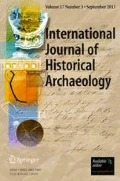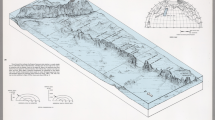Abstract
A zooarchaeological study of fish remains deposited between 1710 and 1900 within a large urban center provides information about households, social hierarchies, and fisheries. Charleston (South Carolina, USA) is an international seaport founded on the southern Atlantic coast of North America in 1670. Fish were important in the city’s cuisine and economy, with Africans involved in many aspects of the fishery. Fish in upper-status townhouse zooarchaeological assemblages are more diverse but from lower trophic levels compared to assemblages from other contexts. This fishery largely focused on in-shore waters until the mid-1800s, when changes presaging those of the twentieth century occurred.






Similar content being viewed by others
References
Berlin, I. (1974). Slaves Without Masters: The Free Negro in the Antebellum South. Oxford University Press, New York.
Bishop, J. M., Ulrich, G., and Wilson, H. S. (1994). “We are in trim to due it”: a review of Charleston’s Mosquito Fleet. Journal of Fisheries Science 2(4): 331–346.
Butler, C. R. (2020). Lowcountry at High Tide: A History of Flooding, Drainage, and Reclamation in Charleston, South Carolina. University of South Carolina Press, Columbia, SC.
Carson, B. G. (1990). Ambitious Appetites: Dining, Behavior, and Patterns of Consumption in Federal Washington. American Institute of Architects Press, Washington, DC.
Clark, T. D. (1973). South Carolina: The Grand Tour 1780-1865. University of South Carolina Press, Columbia, SC.
Colley, S. (2013). Fish and fishing in colonial New South Wales: New evidence from the Quadrant site in Sydney. Post-Medieval Archaeology 47: 119–135.
Curet, L. A. and Pestle, W. J. (2010). Identifying high-status foods in the archaeological record. Journal of Anthropological Archaeology 29: 413–431.
Dahlberg, M. D. (1975). Guide to Coastal Fishes of Georgia. University of Georgia Press, Athens.
Deetz, K. F. (2017). Bound to the Fire: How Virginia’s Enslaved Cooks Helped Invent American Cuisine. University Press of Kentucky, Lexington.
deFrance, S. D. and Kennedy, J. R. (2020). The finny tribe: How coastal, cosmopolitan New Orleans satisfied an appetite for fish. International Journal of Historical Archaeology 24: 367–397. https://doi.org/10.1007/s10761-019-00509-8
Earll, E. (1887). The fisheries of South Carolina. In Goo, G.B. (ed.), The Fisheries and Fishery Industries of the United States, Section II, part XIII. United States Commission on Fish and Fisheries, Government Printing Office, Washington, DC, pp. 504–518.
Edelson, S. M. (2006). Plantation Enterprise in Colonial South Carolina. Harvard University Press, Cambridge, MA.
Eden, T. (2010). The Early American Table: Food and Society in the New World. Northern Illinois University Press, DeKalb.
Edgar, W. (1998). South Carolina: A History. University of South Carolina Press, Columbia,.
Ervynck, A., Van Neer, W., Hüster-Plogmann, H., and Schibler, J. (2003). Beyond affluence: the zooarchaeology of luxury. World Archaeology 34(3): 428–441.
Fraser, W. J., Jr. (1989). Charleston! Charleston! The History of a Southern City. University of South Carolina Press, Columbia.
Froese, R. and Pauly, D. (ed.). (1998). FishBase 98: Concepts, Design and Data Sources. The International Center for Living Resources Management, Makati City, Philippines.
Griffin, P. C. (1990). Mullet on the beach: the Minorcans of Florida, 1768–1788. El Escribano 27: 1–219.
Grosvenor, V. (2011). Vibration Cooking; or, the Travel Notes of a Geechee Girl. Doubleday, Garden City, New York.
Harris, J. B. (2011). High on the Hog: A Culinary Journey from Africa to America. Bloomsbury, New York.
Hart, E. (2010). Building Charleston: Town and Society in the Eighteenth-century British Atlantic World. University of Virginia Press, Charlottesville.
Hart, E. (2020). Atlantic and local: scales of interdependence in eighteenth century Charleston, South Carolina. Almanack, Guarulhos, 24, edoo310, https://doi.org/10.1590/2236-463324edoo319.
Hess, K. (1992). The Carolina Rice Kitchen: The African Connection. University of South Carolina Press, Columbia.
Hilliard, S. B. (1972). Hog Meat and Hoecake: Food Supply in the Old South, 1840–1860. University of Georgia Press, Athens.
Hooker, R. J. (ed.) (1984). A Colonial Plantation Cookbook: The Receipt Book of Harriott Pinckney Horry, 1770. University of South Carolina Press, Columbia.
IJzereef, G. F. (1988). Animal bones and social stratification: a preliminary analysis of the faunal remains from cess-pits in Amsterdam (1600–1850 A.D.). Archaeozoologia II/1, 2: 283–292.
Klippel, W. E. and Sichler, J. A. (2004). North Atlantic fishes in inland context: pickled mackerel (Scomber scombrus) in the historic period. Historical Archaeology 38: 12–24.
Lambert, J. (1810). Travels through Lower Canada and the United States of North America in the Years 1806, 1807, and 1808. Richard Phillips, London.
Manigault, G. (1899). Autobiography. Manigault Papers #484, Files 2-5. Manuscript Department, Southern Historical Collection, University of North Carolina, Chapel Hill.
Marrinan, R. A. (2010). Two Late Archaic period shell rings, St. Simon’s Island, Georgia. In Thomas, D. H. and Sanger, M. C. (eds.), Trend, Tradition, and Turmoil: What Happened to the Southeastern Archaic? American Museum of Natural History, New York, pp. 171–102.
Merrens, H. R. (1977). The Colonial South Carolina Scene: Contemporary Views, 1697–1774. University of South Carolina Press, Columbia.
Milne, C. and Crabtree, P. J. (2001). Prostitutes, a Rabbi, and a carpenter – dinner at the Five Points in the 1830s. Historical Archaeology 35(3): 31-48.
Minis, W. and Butler, N. (2007). A Return to Centre Market. Post and Courier, Charleston, South Carolina, July 16.
Morgan, P. D. (1998). Slave Counterpoint: Black Culture in the Eighteenth-Century Chesapeake and Lowcountry. University of North Carolina Press, Chapel Hill.
Olwell, R. (1996). “Loose, idle and disorderly”: slave women in the eighteenth-century Charleston marketplace. In Gaspar, D. B. and Hine, D. C. (eds.), More Than Chattel: Black Women and Slavery in the Americas. Indiana University Press, Bloomington, pp. 97–110.
Paston-Williams, S. (1993). The Art of Dining: A History of Cooking and Eating. National Trust, London.
Pauly, D. and Christensen, V. (1995). Primary production required to sustain global fisheries. Nature 374: 255–257.
Reitz, E. J. (1986). Urban/rural contrasts in vertebrate fauna from the southern coastal plain. Historical Archaeology 20(2): 47–58.
Reitz, E. J. (1987). Vertebrate fauna and socio-economic status. In Spencer-Wood, S. (ed.), Consumer Choice in Historical Archaeology. Plenum, New York, pp. 101–119.
Reitz, E. J. (1994). Zooarchaeological analysis of a free African community: Gracia Real de Santa Teresa de Mose. Historical Archaeology 28: 23–40.
Reitz, E. J. (2004). “Fishing down the food web”: a case study from St. Augustine, Florida, USA. American Antiquity 69: 63–83.
Reitz, E. J. and Cumbaa, S. L. (1983). Diet and foodways of eighteenth-century Spanish St. Augustine. In Deagan, K. (ed.), Spanish St. Augustine: The Archaeology of a Colonial Creole Community. Academic Press, New York, pp. 151–186.
Reitz, E. J., Ruff, B. L., and Zierden, M. A. (2006). Pigs in Charleston, South Carolina: using specimen count to consider status. Historical Archaeology 40: 104–124.
Reitz, E. J. and Waselkov, G. (2015). Vertebrate use at early colonies in the southeastern coasts of eastern North America. International Journal of Historical Archaeology 19: 21–45.
Reitz, E. J. and Wing, E. S. (2008). Zooarchaeology. 2nd ed. Cambridge University Press, Cambridge.
Reitz, E. J. and Zierden, M. A. (1991). Cattle bones and status from Charleston, South Carolina. In Purdue, J. R., Klippel, W. E. and Styles, B. W. (eds.), Beamers, Bobwhites, and Blue-Points: Tributes to the Career of Paul W. Parmalee. Illinois State Museum, Springfield, pp. 395–407.
Reitz, E. J. and Zierden, M. A. (2014). Wildlife in urban Charleston, South Carolina, USA. Anthropozoologica 49: 33–46.
Reitz, E. J. and Zierden, M. A. (2021). From Charleston to St. Augustine: changes in the central Georgia Bight (USA) fishery, AD 1565–1900. Journal of Archaeological Science: Reports: doi.org/10.1016/j.jasrep.2021.102791.
Robins, C. R., Ray, G. C., and Douglass, J. (1986). A Field Guide to Atlantic Coast Fishes of North America. Houghton Mifflin, Boston.
Robinson, S. A. (2003). Gullah Home Cooking the Dafuskie Way. University of North Carolina Press, Chapel Hill.
Rosengarten, T. (1986). Tombee: Portrait of a Cotton Planter. William Morrow, New York.
Rutledge, S. (2013 [1847]). The Carolina Housewife, or House and Home by a Lady of Charleston. Andrews McMeels, Kansas City, MO.
Shannon, C. E. and Weaver, W. (1949). The Mathematical Theory of Communication. University of Illinois Press, Urbana.
Sharp, K. K. (2018). Planters’ Plots to Backlot Stewpots: Food, Race, and Labor in Charleston, South Carolina, 1780–1850. Doctoral dissertation, University of California-Davis, Davis.
Shields, D. S. (2015). Southern Provisions: The Creation and Revival of a Cuisine. University of Chicago Press, Chicago.
Shields, D. S. (2017). The Culinarians: Lives and Careers from the First Age of American Fine Dining. University of Chicago Press, Chicago.
Singer, D. A. (1987). Threshold of affordability: assessing fish remains for socioeconomics. In Spencer-Wood, S. (ed.), Consumer Choice in Historical Archaeology. Plenum, New York, pp. 85–99.
Smith, D. E. H. (1950). A Charlestonian’s Recollections, 1846–1913. Carolina Art Association, Charleston, South Carolina.
Smith, H. R. (2019). Carolina’s Golden Fields: Inland Rice Cultivation in the South Carolina Lowcountry, 1670–1860. Cambridge University Press, Cambridge.
Twitty, M. W. (2017). The Cooking Gene: A Journey Through African American Culinary History in the Old South. Harper Collins, New York.
Van der Veen, M. (2003). When is food a luxury? World Archaeology 34(3): 405–427.
Waddell, G. (1980). Indians of the South Carolina Lowcountry 1562-1751. Reprint Company, Spartanburg, South Carolina.
Warner, W. L. (1962). American Life: Dream and Reality. University of Chicago Press, Chicago.
White, T. E. (1953). A method of calculating the dietary percentage of various food animals utilized by aboriginal peoples. American Antiquity 17: 396–398.
Wilk, R. R. (1999). “Real Belizean Food”: building local identity in the transnational Caribbean. American Anthropologist 101: 244–255.
Zierden, M. A. (1996). Big House, Back Lot: An Archaeological Study of the Nathaniel Russell House. Charleston Museum, Charleston, SC.
Zierden, M. A. and Reitz, E. J. (2002). Eighteenth-century Charleston: aftermath of the siege. El Escribano 39: 113–131.
Zierden, M. A. and Reitz, E. J. (2009). Animal use and the urban landscape in colonial Charleston, South Carolina, USA. International Journal of Historical Archaeology 13: 327–365.
Zierden, M. A. and Reitz, E. J. (2016). Charleston: An Archaeology of Life in a Coastal Community. University of Florida Press, Gainesville.
Zierden, M. A., Reitz, E. J., Pavao-Zuckerman, B., Reitsema, L. J., and Manzano, B. L. (2019). What is this bird? the quest to identify parrot remains from the Heyward-Washington House, Charleston, South Carolina. Southeastern Archaeology 38: 240–250.
Acknowledgments
We gratefully acknowledge the contribution made by numerous people who helped us develop these ideas. The list is now too lengthy to repeat here; but special recognition is due to the citizens of Charleston, whose interest in their city’s heritage supported our work in tangible and intangible ways. We are indebted to David Shields for his culinary research. His detailed and careful analysis of Charleston’s market and dining scene, particularly his account of C.C. Leslie’s story, provides a sound basis for comparison to the archaeological data. We are grateful for the support of the City of Charleston, particularly of former mayor Joseph P. Riley, Jr. The Charleston Museum has a long history of embracing archaeology, which has made this long-term study possible. We are grateful for the support of the staff, faculty, and students of the Charleston County Public Library, Historic Charleston Foundation, Old Exchange Building and Provost Dungeon, the Preservation Society of Charleston, the South Carolina Historical Society, South Carolina Department of Archives and History, South Carolina Institute of Archaeology and Anthropology, and The College of Charleston. We appreciate the assistance of the reviewers who helped us improve the manuscript. Fig. 1 was drafted by Susan G. Duser. An earlier version of this paper was presented at the 18th International Conference of Archaeozoology Fish Remains Working Group, Lisbon, Portugal in 2015.
Author information
Authors and Affiliations
Corresponding author
Additional information
Publisher’s Note
Springer Nature remains neutral with regard to jurisdictional claims in published maps and institutional affiliations.
Rights and permissions
About this article
Cite this article
Reitz, E.J., Zierden, M.A. A Zooarchaeological Study of Households and Fishing in Charleston, South Carolina, USA, 1710–1900. Int J Histor Archaeol 25, 1087–1112 (2021). https://doi.org/10.1007/s10761-021-00590-y
Accepted:
Published:
Issue Date:
DOI: https://doi.org/10.1007/s10761-021-00590-y




